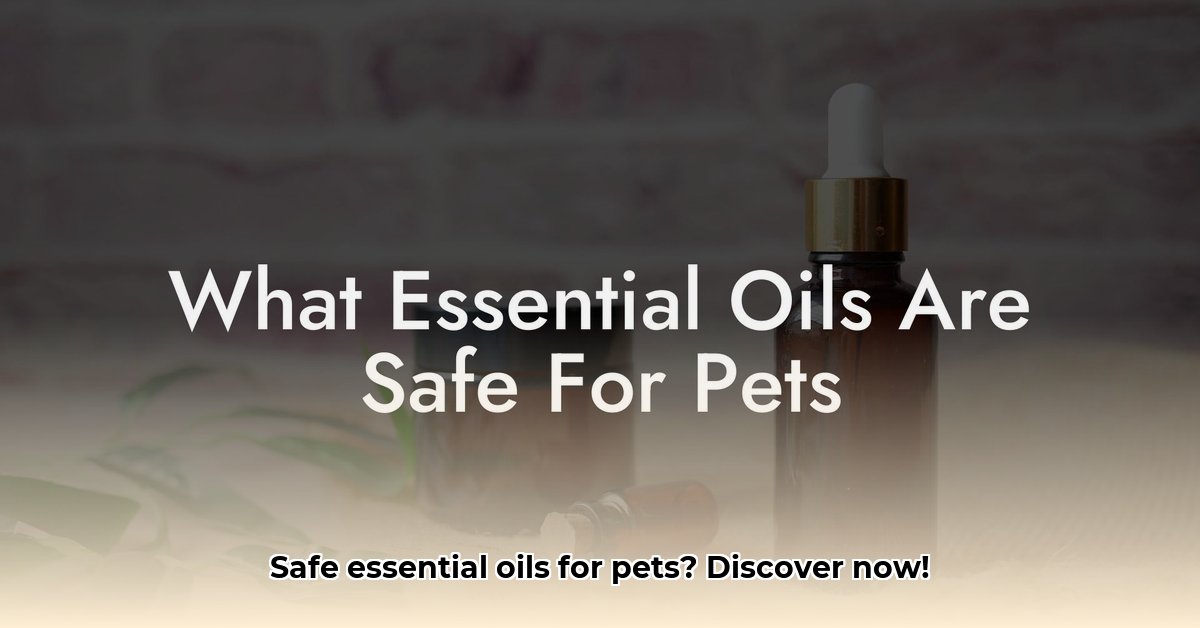Are you considering using essential oils around your beloved pets? The allure of natural fragrances and potential therapeutic benefits is strong, but it’s paramount to prioritize safety. Many essential oils can pose significant risks to both cats and dogs. This in-depth guide provides vet-informed advice on how to navigate the world of essential oils responsibly, ensuring a healthy environment for your furry companions.
Essential Oils and Your Pet’s Health
While essential oils are increasingly popular for human use, it’s crucial to recognize that pets react differently. What might be a pleasant aroma for you could be harmful, or even toxic, to your cat or dog. Their unique physiology makes them more vulnerable to the concentrated compounds found in these oils. Cats, due to their specific metabolic pathways, are particularly susceptible to adverse effects.
Understanding the Potential Risks: Aromatic Hazards
Essential oils are highly concentrated extracts derived from plants. These potent substances contain volatile organic compounds that can be rapidly absorbed through the skin, inhaled into the respiratory system, or ingested through grooming. The concentrated nature of these oils means that even small amounts can have significant effects on your pet’s health.
Specifically, essential oils can:
- Irritate the skin: Causing redness, itching, and inflammation.
- Damage the respiratory tract: Leading to coughing, wheezing, and difficulty breathing.
- Affect the nervous system: Resulting in lethargy, tremors, or seizures.
- Cause liver damage: As the liver works to metabolize the concentrated compounds.
The severity of these effects depends on several factors, including the type of oil, the concentration, the method of exposure, and the individual pet’s sensitivity. Therefore, a thorough understanding of essential oil safety is crucial before introducing them into your pet’s environment.
Safe Essential Oils: A Carefully Selected List
While many essential oils are harmful to pets, a few are considered relatively safe when used with extreme caution and proper dilution. These include:
- Lavender: Known for its calming properties, lavender can help reduce anxiety and promote relaxation.
- Chamomile: Another gentle oil with soothing effects, chamomile can help calm nerves and ease skin irritations.
- Frankincense: Renowned for its grounding and balancing properties, frankincense may help reduce stress and support overall well-being.
- Cedarwood: Can create a calming atmosphere, aiding in better sleep and relaxation for your pet.
- Sweet Orange: Its bright scent uplifts moods and can create a cheerful environment for both you and your pets.
- Lemongrass: Effectively deodorizes pet areas while being completely safe.
Even with these “safe” oils, it’s crucial to remember that individual pets can react differently. Always introduce essential oils gradually and monitor your pet closely for any signs of adverse reactions.
Here’s a more detailed breakdown:
| Essential Oil | Pet Safety Level | Potential Benefits | Cautions |
|---|---|---|---|
| Lavender | Generally Low Risk | Calming, may help with anxiety | Dilute heavily (1-3% max), conduct a patch test first, avoid ingestion, ensure adequate ventilation, discontinue use if irritation occurs |
| Chamomile | Generally Low Risk | Calming, may soothe skin irritations | Dilute heavily (1-3% max), conduct a patch test first, avoid ingestion, ensure adequate ventilation, discontinue use if irritation occurs |
| Frankincense | Generally Low Risk | Calming, may support respiratory health | Dilute heavily (1-3% max), conduct a patch test first, avoid ingestion, ensure adequate ventilation, discontinue use if irritation occurs |
| Cedarwood | Generally Low Risk | Calming atmosphere, relaxation and better sleep | Dilute heavily (1-3% max), conduct a patch test first, avoid ingestion, ensure adequate ventilation, discontinue use if irritation occurs |
| Sweet Orange | Generally Low Risk | Uplifts moods and creates a cheerful environment | Dilute heavily (1-3% max), conduct a patch test first, avoid ingestion, ensure adequate ventilation, discontinue use if irritation occurs |
| Lemongrass | Generally Low Risk | Effectively deodorizes pet areas | Dilute heavily (1-3% max), conduct a patch test first, avoid ingestion, ensure adequate ventilation, discontinue use if irritation occurs |
| Peppermint | Moderate Risk | May help with some digestive issues | Use with EXTREME caution, only topical use in highly diluted form (consult a veterinarian), avoid ingestion entirely, monitor closely |
| Tea Tree (Melaleuca) | High Risk | NOT RECOMMENDED | NEVER use around pets – highly toxic, can cause severe neurological symptoms, liver damage, and skin irritation |
| Citrus Oils (general) | High Risk | NOT RECOMMENDED | NEVER use around pets, especially cats – can cause skin irritation, drooling, tremors, and liver damage |
Important Considerations:
- Quality Matters: Always use 100% pure, therapeutic-grade essential oils from reputable sources.
- Individual Sensitivity: Each pet is unique, and reactions can vary.
- Contraindications: Certain health conditions may make essential oil use unsafe for your pet. Consult your veterinarian.
Safe Application Methods: Dilution and Diffusion Guidelines
The key to safe essential oil use around pets is proper dilution and application. Never apply undiluted essential oils directly to your pet’s skin or fur.
Dilution Techniques:
- Carrier Oils: Use a high-quality carrier oil, such as fractionated coconut oil, olive oil, or jojoba oil, to dilute the essential oil.
- Dilution Ratio: A general guideline is a 1-3% dilution. This means 1-3 drops of essential oil per 10 ml (approximately 2 teaspoons) of carrier oil. Start with the lowest concentration and increase gradually as needed, while closely monitoring your pet.
- Patch Test: Before applying the diluted oil to a larger area, perform a patch test. Apply a small amount to a discrete area of your pet’s skin and observe for 24 hours for any signs of irritation.
Topical Application:
- Targeted Areas: Apply the diluted oil to specific areas, such as the paws, ears or along the spine, avoiding sensitive areas like the eyes, nose, and genitals.
- Gentle Massage: Gently massage the diluted oil into the fur, ensuring it’s absorbed into the skin.
- Avoid Ingestion: Prevent your pet from licking or ingesting the oil. Consider using a cone or Elizabethan collar if necessary.
Diffusion Safety:
Diffusing essential oils around pets requires extreme caution. Their sensitive respiratory systems can be easily irritated by airborne particles.
- Well-Ventilated Areas: Only diffuse essential oils in well-ventilated areas where your pet can easily leave if they feel uncomfortable.
- Limited Exposure: Limit diffusion time to 10-15 minutes at a time, and avoid prolonged or continuous diffusion.
- Waterless Diffusers: Consider using a waterless diffuser, which releases essential oils in a more controlled manner.
- Avoid Direct Contact: Ensure the diffuser is placed out of your pet’s reach to prevent accidental ingestion or contact.
Recognizing Signs of Toxicity: Prompt Response
Even with careful application, adverse reactions can occur. Be vigilant and watch for the following signs of essential oil toxicity:
- Excessive drooling or salivation
- Vomiting or diarrhea
- Skin irritation, redness, or swelling
- Lethargy or weakness
- Difficulty breathing or rapid breathing
- Coughing or wheezing
- Tremors or seizures
- Loss of coordination or stumbling
If you observe any of these symptoms, discontinue essential oil use immediately and seek veterinary care.
The Importance of Veterinary Consultation: Expert Guidance
The information provided in this guide is intended for educational purposes only and should not be considered a substitute for professional veterinary advice. Before using any essential oil around your pet, consult with your veterinarian. They can assess your pet’s individual health status, identify potential risks, and provide tailored recommendations for safe and effective essential oil use.
Key Takeaways:
- Essential oils can be harmful to pets, particularly cats.
- Use only safe essential oils and always dilute them properly.
- Never apply undiluted essential oils directly to your pet’s skin.
- Exercise extreme caution when diffusing essential oils around pets.
- Monitor your pet closely for any signs of adverse reactions.
- Consult with your veterinarian before using essential oils near your pet.
- Plastic Bento Boxes Face Scrutiny Over Sustainability Impacts - December 11, 2025
- Bento Tray Revolutionizes Organized Meal Transport and Presentation - December 10, 2025
- Meal Plans for Busy Schedules That Make Healthy Eating Easy - December 10, 2025










